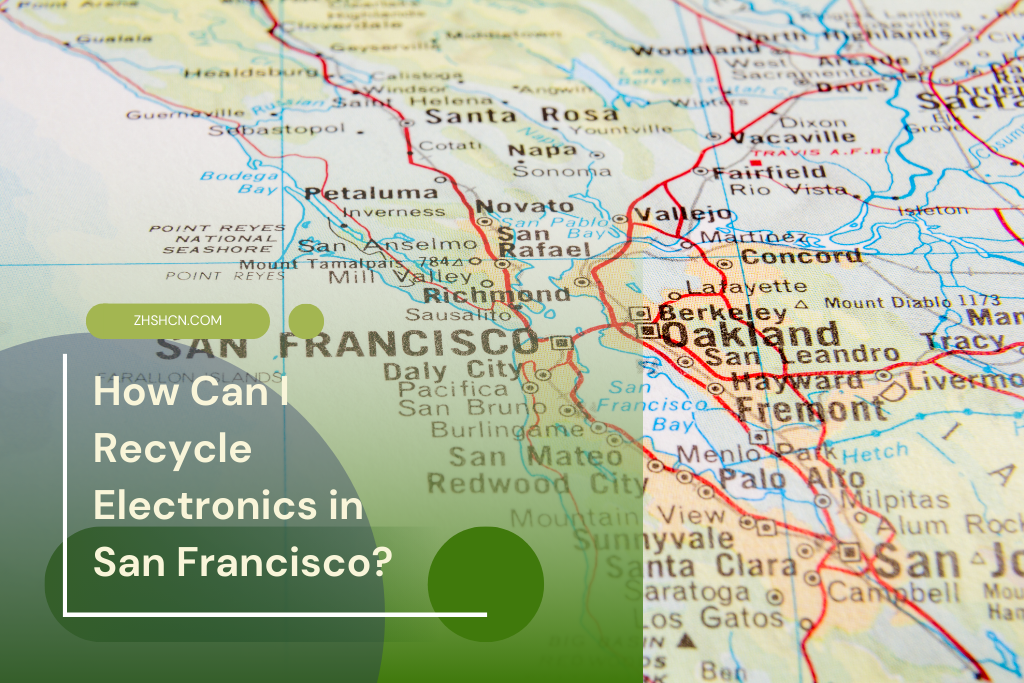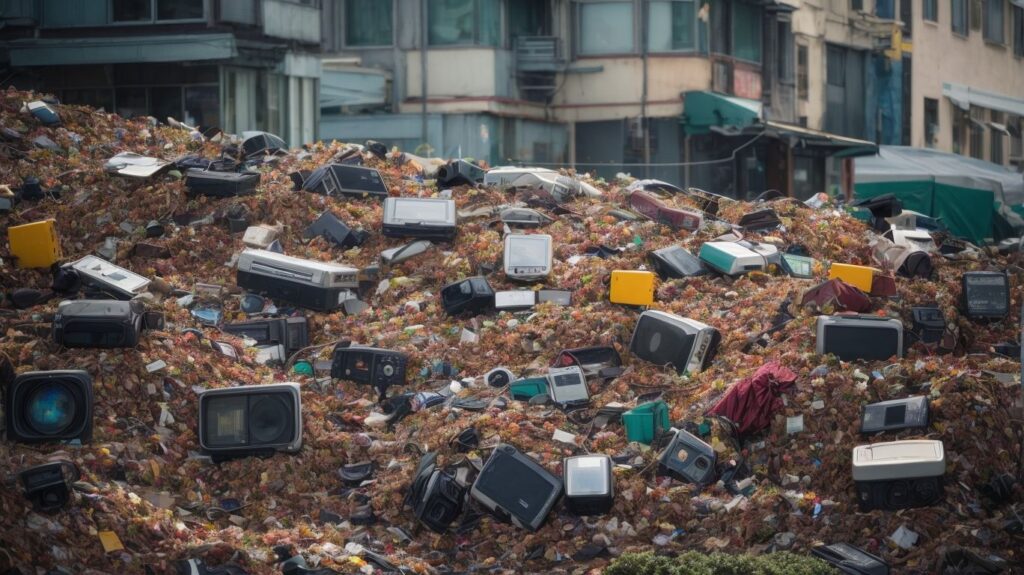Electronic waste recycling is a crucial practice in the modern age, considering the harmful impact of improper electronic disposal on the environment and human health. San Francisco, known for its sustainability commitment, offers various electronics recycling options. Understanding the importance of electronics recycling is the first step in taking responsibility for our electronic waste. An important aspect to delve into is “How to Recycle Electronics in San Francisco?” as it provides a practical approach to embodying sustainability in our actions, particularly in a tech-savvy locale like San Francisco.
Options for recycling electronics in San Francisco include the city’s Municipal Electronics Recycling Program, certified e-waste recyclers, and manufacturer and retailer recycling programs. Each option ensures that electronic devices are properly recycled or disposed of, minimizing their adverse environmental effects.
Key takeaways:
- San Francisco’s Municipal Electronics Recycling Program: Take advantage of the city’s program to ensure proper and responsible electronic waste disposal.
- Certified E-Waste Recyclers in San Francisco: Consider using certified recyclers to guarantee that your electronics are recycled in an environmentally friendly manner.
- Manufacturer and Retailer Recycling Programs: Check if the manufacturer or retailer of your electronics offers recycling programs to easily and conveniently recycle your old devices.
Why is Electronics Recycling Important?
Why is Electronics Recycling Important?
Electronics recycling is important for several reasons. It helps prevent environmental pollution caused by hazardous substances contained in electronic devices, like lead and mercury. Recycling also conserves valuable natural resources by recovering materials such as gold, silver, and copper from old electronics. Additionally, it reduces the demand for new raw materials, minimizing the destructive impact of mining. The significance of electronics recycling lies in its ability to prevent electronic waste from ending up in landfills, thereby reducing the space needed for waste disposal and the associated environmental risks. Ultimately, electronics recycling is crucial in sustainable resource management and environmental protection.
Options for Recycling Electronics in San Francisco
Looking for ways to recycle your old electronics in San Francisco responsibly? Look no further!
In this section, we’ll explore various options available to you.
From San Francisco’s Municipal Electronics Recycling Program to certified e-waste recyclers and even manufacturer and retailer recycling programs, we’ve got you covered. Discover how you can contribute to a greener environment while disposing of your electronic devices in the most sustainable way possible.
1. San Francisco’s Municipal Electronics Recycling Program
San Francisco’s Municipal Electronics Recycling Program is a convenient and responsible way to dispose of electronic waste. This program provides drop-off locations throughout the city where residents can safely recycle unwanted electronics. By participating in this program, you can help prevent harmful materials from ending up in landfills and reduce the environmental impact of electronic waste. To maximize the benefits of this program, ensure you properly prepare your electronics for recycling by deleting personal data, removing batteries, and packaging and labeling them appropriately. By utilizing San Francisco’s Municipal Electronics Recycling Program, you can contribute to a cleaner and greener city.
2. Certified E-Waste Recyclers in San Francisco
There are several certified e-waste recyclers in San Francisco that can help you responsibly dispose of your electronic devices. These recyclers have been certified to meet certain standards and guidelines for handling electronic waste. Here are some options to consider:
| 1. GreenCitizen: | GreenCitizen is a certified e-waste recycler in San Francisco that offers convenient drop-off locations and also provides pick-up services for businesses. |
| 2. Recology: | Recology is another certified e-waste recycler in San Francisco that offers drop-off locations where you can safely dispose of your electronic devices. |
| 3. Advanced Technology Recycling: | Advanced Technology Recycling is a nationwide e-waste recycling company that operates in San Francisco and provides secure and environmentally friendly recycling services. |
| 4. Sims Recycling Solutions: | Sims Recycling Solutions is a global e-waste recycling company that has a facility in San Francisco and offers services to businesses and individuals. |
By choosing a certified e-waste recycler, you can ensure that your electronic devices are properly handled and recycled, minimizing the environmental impact of electronic waste.
3. Manufacturer and Retailer Recycling Programs
Manufacturer and retailer recycling programs are an integral part of electronic waste management. These programs play a vital role in enabling consumers to dispose of their old electronic devices responsibly while ensuring that the materials are recycled and reused rather than being dumped in landfills.
Let’s take a look at some essential details about these manufacturer and retailer recycling programs:
| Convenient Drop-off Locations |
|---|
| Many manufacturers and retailers provide convenient drop-off locations where consumers can recycle their old electronics. |
| Acceptance of a Wide Range of Devices |
|---|
| These programs typically accept various electronic devices, including smartphones, laptops, printers, televisions, mobile phones, scanners, etc. |
| Proper Handling of Devices |
|---|
| Manufacturers and retailers prioritize properly handling the collected devices, ensuring data security and environmentally friendly processes. |
| Free of Charge |
|---|
| Most manufacturer and retailer recycling programs are free of charge for consumers, making it easier and more accessible to recycle electronic waste. |
How to Prepare Electronics for Recycling
Regarding recycling electronics in San Francisco, it’s crucial to know how to prepare them for recycling properly. This section will dive into the essential steps you need to take. From deleting personal data to removing batteries and packaging and labeling, we’ll cover everything you need to ensure a seamless and environmentally conscious recycling process. So grab your devices and get ready to impact our planet positively.
1. Deleting Personal Data
When recycling electronics in San Francisco, it is crucial to delete personal data to protect your privacy properly. To securely erase your personal information, follow these steps:
- Begin by backing up all your important files and data.
- Next, utilize factory reset options or wiping software to delete all personal data from the device.
- Make sure to remove any external storage devices or SIM cards.
- Confirm that all data has been completely erased by checking the settings and storage.
- Dispose of the device through San Francisco’s Municipal Electronics Recycling Program or at an authorized recycling facility.
Pro-tip: Consider utilizing data erasure software that meets recognized industry standards for secure data deletion.
2. Removing Batteries
Removing Batteries When Recycling Electronics in San Francisco
Removing batteries is essential when recycling electronics in San Francisco to ensure safe and environmentally friendly disposal. Follow these steps to remove batteries properly:
- Locate the battery compartment on your device.
- Use a small screwdriver or coin to open the battery compartment easily.
- Gently extract the batteries, being cautious not to cause any damage.
- Place the batteries in a separate container for safe transportation to a battery recycling facility.
- Dispose of the device and batteries exclusively at authorized electronic recycling centers or designated drop-off locations.
Always remember that batteries can be hazardous if not disposed of appropriately. By following these steps, you actively contribute to a cleaner and safer environment in San Francisco.
Don’t forget to share this valuable information with friends and family to promote responsible electronics recycling practices within the community.
3. Packaging and Labeling
Proper packaging and labeling play a crucial role in preparing electronics for recycling. These measures are essential to ensure the safe handling and efficient e-waste processing. Below is a
summarizing the important considerations for packaging and labeling:
| Packaging | Labeling |
|---|---|
| Utilize sturdy boxes or padding materials to safeguard the electronics during transportation. | Mark the package as “Electronic Waste” to prevent confusion and ensure proper handling. |
| Securely seal the package to prevent any damage or leaks. | Include relevant information, such as the device type or condition, on the label. |
| Separate smaller items or components within the package to avoid tangling or damage. | Indicate whether the battery is removable or non-removable for safe handling. |
| Before packaging, remove any personal or sensitive data from the device. | If applicable, include specific instructions or warnings for the recycling facility. |
Fact: Proper packaging and labeling not only facilitate the recycling process but also help minimize the environmental impact of electronic waste.
Accepted Electronics for Recycling in San Francisco
In San Francisco, recycling electronics is encouraged and essential for protecting the environment. Whether you have old computers, televisions, mobile phones, or printers, this section will guide you through the accepted electronics for recycling. Discover how to responsibly dispose of these items and contribute to a cleaner and greener city. We’ll cover everything from computers and laptops to televisions and printers. So, let’s dive in and learn how to make a positive impact with our electronic recycling efforts.
1. Computers and Laptops
Computers and Laptops: Importance of Proper Recycling
Computers and laptops are commonplace electronic items that should undergo proper recycling to minimize their environmental impact. Here are some crucial points to consider when it comes to recycling computers and laptops:
- Delete Personal Data: Before recycling, it is essential to ensure that all personal data is completely erased or securely wiped from the device.
- Remove Batteries: It is important to take out any batteries from laptops and other portable devices before initiating the recycling process.
- Package and Label: It is vital to properly package the computer or laptop for transportation to the recycling facility. Additionally, make sure to clearly label it as electronic waste.
Recycling computers and laptops is paramount because they contain hazardous materials like lead, mercury, and cadmium. These substances can severely harm the environment if not disposed of correctly. Recycling these electronic devices allows valuable materials to be recovered and reused, reducing the need for virgin resources. Moreover, proper recycling prevents e-waste from ending up in landfills and causing further harm.
2. Televisions and Monitors
Televisions and monitors are common electronic devices that require proper recycling due to their environmental impact. Here are some key considerations when recycling televisions and monitors in San Francisco:
- Find authorized recycling programs or drop-off locations in the city, such as San Francisco’s Municipal Electronics Recycling Program for televisions and monitors.
- Ensure data security by wiping personal information from the televisions and monitors before recycling.
- Detach any batteries or power cords from the televisions and monitors and recycle them separately.
- Package and label the televisions and monitors properly to prevent damage during transportation.
Fact: Recycling one million laptops saves the energy equivalent of powering 3,500 U.S. homes for a year.
3. Mobile Phones and Tablets
When it comes to recycling mobile phones and tablets in San Francisco, there are several options available. You can participate in San Francisco‘s Municipal Electronics Recycling Program, which accepts mobile phones and tablets for recycling. Another option is to contact certified e-waste recyclers in San Francisco who specialize in handling electronic devices like mobile phones and tablets. Additionally, you can explore manufacturer and retailer recycling programs that often accept old mobile phones and tablets.
Remember to prepare your mobile phones and tablets for recycling by deleting personal data, removing batteries, and packaging and labeling them properly.
4. Printers and Scanners
Regarding recycling printers and scanners in San Francisco, following the proper disposal process is important to protect the environment. Here are some steps to consider:
- Evaluate the condition: Determine if the printers and scanners are still functional or need repair.
- Donate or Sell: If the devices are in good working condition, consider donating them to a non-profit organization or selling them to someone in need.
- Recycling Programs: Check if San Francisco’s Municipal Electronics Recycling Program or certified e-waste recyclers accept printers and scanners.
- Manufacturer and Retailer Programs: Some manufacturers and retailers offer their own recycling programs where you can drop off your old printers and scanners.
Remember, it’s always best to recycle printers and scanners responsibly to minimize environmental impact. And a pro tip: Remove personal data or sensitive information from the printers and scanners to protect your privacy before recycling.
Disposing of Electronic Waste Responsibly
Are you wondering how to dispose of your electronic waste in San Francisco responsibly? Look no further! In this section, we’ll explore the importance of proper e-waste handling and the measures you can take to ensure data security. You’ll discover the necessary steps to create a cleaner environment while safeguarding your personal information. Let’s delve into the world of electronic waste disposal and discover how you can positively impact today!
1. Proper E-Waste Handling
Proper e-waste handling is crucial to ensure the safe disposal and recycling of electronic devices. It is important to follow these steps to handle e-waste responsibly:
- Research local recycling options and identify certified e-waste recyclers in your area.
- Remove personal data by wiping or resetting devices to factory settings.
- Take out batteries and dispose of them separately to prevent leaks or fires.
- Package and label the electronic devices securely, protecting them during transportation.
If you cannot find local recycling options, consider contacting manufacturers or retailers to inquire about their recycling programs. By adhering to proper e-waste handling practices, you can contribute to minimizing environmental impact and safeguarding your personal information.
2. Data Security
Data security is a crucial aspect of electronics recycling. It ensures that personal information stored on devices is properly erased to prevent unauthorized access. Here is a table outlining the steps to take for
| 1. Deleting Personal Data | Erase all personal files and accounts from the device before recycling. |
| 2. Removing Batteries | Remove batteries from electronic devices to prevent any power supply that could potentially access data. |
| 3. Packaging and Labeling | Securely pack the device and label it “For Recycling” to avoid confusion or accidental data breaches. |
By following these steps, individuals can ensure that their personal data remains confidential during the electronics recycling.
Benefits of Electronics Recycling
- Environmental conservation: Recycling electronics prevents hazardous materials like lead and mercury from contaminating soil and water.
- Resource preservation: Recycling electronics reduces the need for raw materials, conserving energy and reducing greenhouse gas emissions.
- Data security: Proper recycling ensures secure disposal of personal and sensitive information, protecting against identity theft.
- Economic opportunities: Electronics recycling creates jobs, supports local economies, and promotes sustainable growth.
- Community health: By preventing the release of harmful substances, electronics recycling promotes a healthier living environment for everyone.
The Future of Electronics Recycling in San Francisco
The future of electronics recycling in San Francisco looks promising, with a strong commitment from the city and its residents. Efforts are being made to improve recycling infrastructure and increase awareness about the importance of proper electronic waste disposal. Companies like EcoRecycle lead the way by providing convenient drop-off locations and partnering with local businesses. Educational programs are being implemented in schools to teach students about the environmental impact of electronic waste. With these initiatives, San Francisco is poised to become a model for sustainable electronics recycling practices.
Some Facts About Recycling Electronics in San Francisco:
- ✅ San Francisco offers multiple options for recycling electronic waste, or e-waste, to prevent environmental harm and health risks. (Source: Our Team)
- ✅ The Recology San Francisco Transfer Station accepts a wide range of electronic items for recycling, including computers, laptops, televisions, printers, and more. (Source: Our Team)
- ✅ Residents of San Francisco can schedule a free curbside pick-up of electronic or universal waste through Recology Bulky Item Recycling, with 1-2 free pickups per year. (Source: Our Team)
- ✅ GreenCitizen and Best Buy are other options in San Francisco for recycling electronic waste, including computers, laptops, cell phones, batteries, and fluorescent bulbs. (Source: Our Team)
- ✅ Donating electronic devices in good condition to Goodwill supports community job training and employment programs. (Source: Our Team)
Frequently Asked Questions
How can SF residents recycle electronics in San Francisco?
SF residents can recycle electronics in San Francisco by utilizing various options such as the Recology San Francisco Transfer Station, GreenCitizen, Best Buy, Goodwill, and San Francisco eWaste. These options allow for responsible electronic waste recycling and contribute to a greener future.
What are the health risks associated with improper disposal of electronic waste?
Improper disposal of electronic waste can lead to health risks due to hazardous materials such as lead, mercury, and cadmium in electronic devices. These substances can contaminate soil, water, and air, posing risks to human health and the environment.
Where is the Recology San Francisco Transfer Station located, and what items can be recycled there?
The Recology San Francisco Transfer Station is at Tunnel Ave, San Francisco, California. It accepts a wide range of electronic items for recycling, including computers, laptops, televisions, printers, and more.
How can SF residents schedule a free curbside pick-up for electronic waste?
SF residents can schedule a free curbside electronic waste pick-up through Recology Bulky Item Recycling. This service allows for collecting electronic or universal waste, such as computers, laptops, cell phones, and printers. Each resident is entitled to 1-2 free pickups per year.
What are the drop-off locations for electronic waste recycling in San Francisco?
Some drop-off locations for electronic waste recycling in San Francisco include GreenCitizen, Best Buy stores, Goodwill Donation Centers, and ewasteSF, located at 2915 16th Street, San Francisco, California.
What items require special handling for recycling or disposal in San Francisco?
Electronic cords and chargers require special handling for recycling or disposal in San Francisco. SF residents can use the Recology Bulky Item Recycling Pick-up Service to safely dispose of these items by placing them in a sealed box marked as “E-Waste.” Drop-off locations such as ewasteSF, Goodwill Donation Centers, and Out of the Closet also accept electronic cords and chargers.
In conclusion, by actively participating in electronics recycling in San Francisco, we can contribute to the city’s sustainability goals and protect the environment for future generations.


